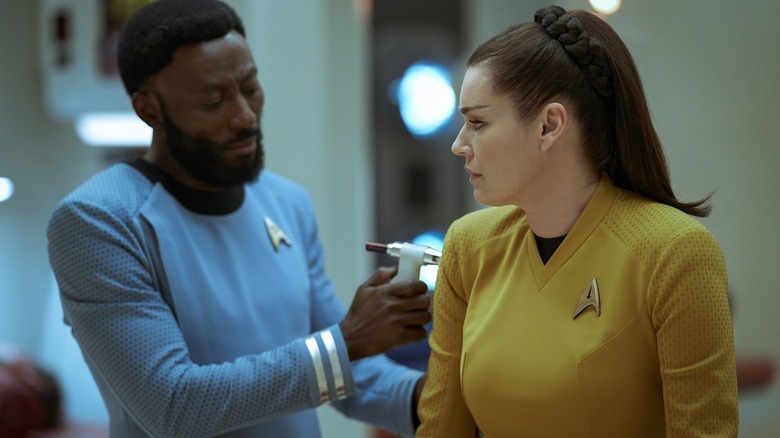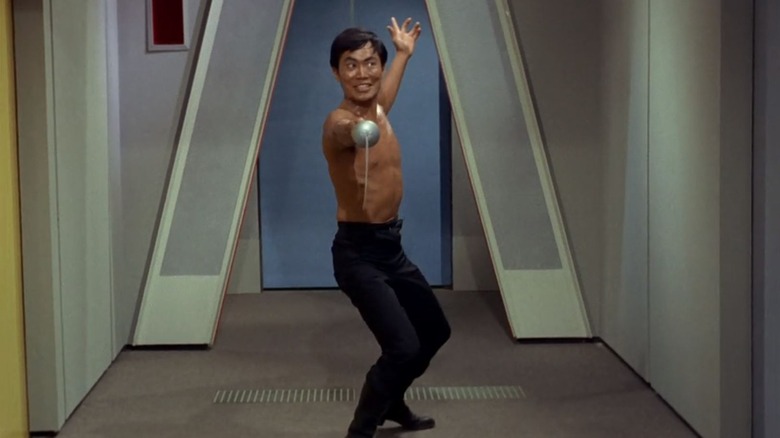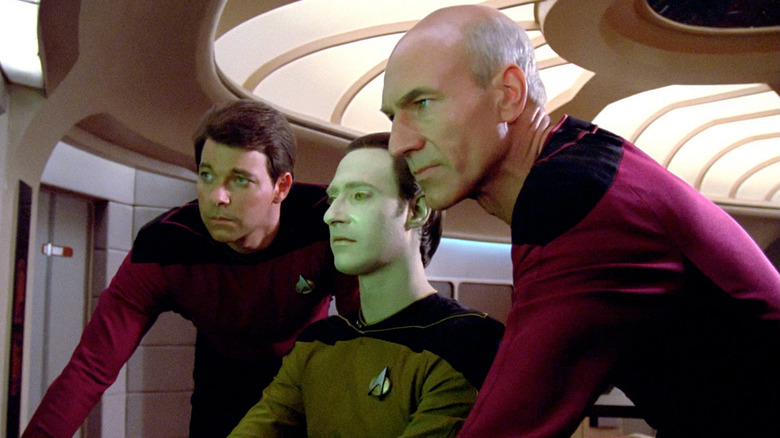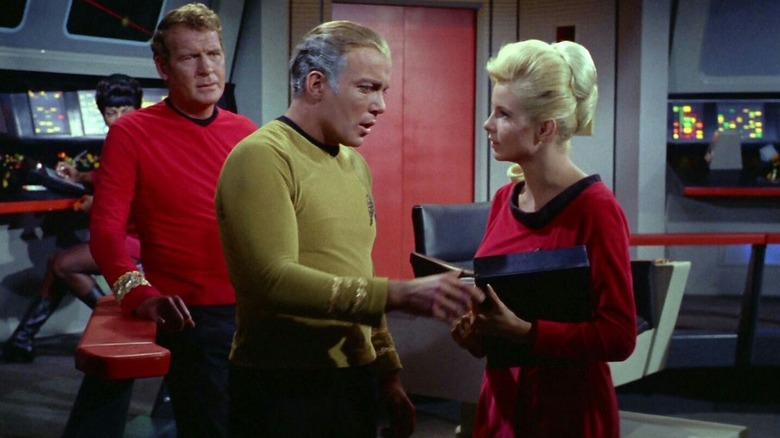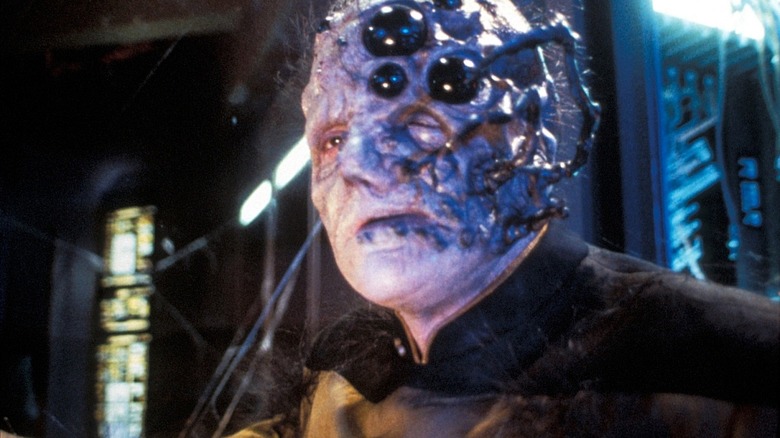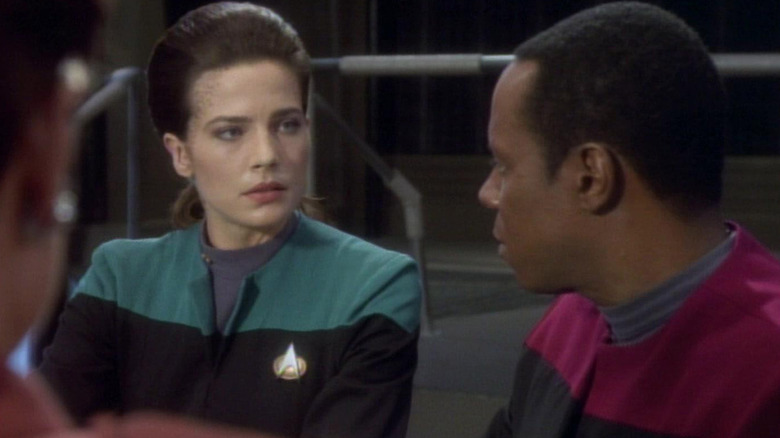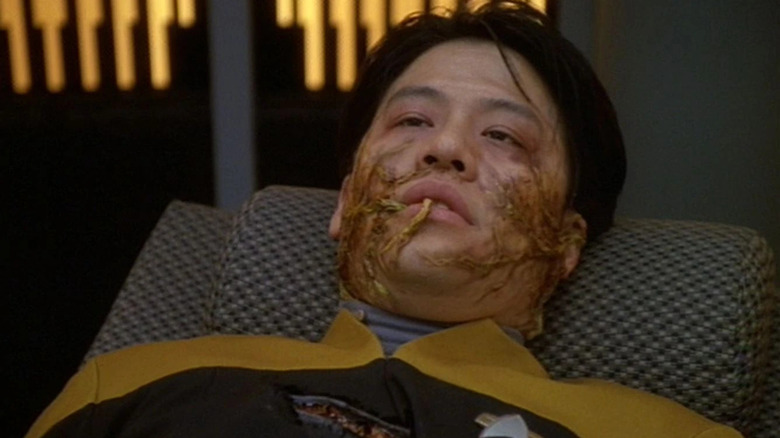The Classic Star Trek Episodes That Inspired Strange New Worlds Episode 3
The third episode of "Star Trek: Strange New Worlds" — entitled "Ghosts of Illyria," written by Akela Cooper and Bill Wolkoff — involves a mysterious contagious disease that infiltrates the Enterprise after an away team visits a seemingly abandoned planet called Illyria. Those infected find themselves, like moths, drawn toward and mesmerized by bright lights, likely due to a sudden lack of vitamin D. The only person who appears to be immune is Cmdr. Una Chin-Riley (Rebecca Romijn), who manages to solve the problem nearly singlehandedly while Capt. Pike (Anson Mount) and Spock (Ethan Peck) remain on the planet's surface facing a crisis of their own.
Contagion/disease episodes are common and expected from "Star Trek." Given that each of the shows takes place largely in space (occasional away missions and most of "Star Trek: Picard" notwithstanding), every "Star Trek" cast must necessarily be confined to an enclosed starship or space station. With little chance to isolate, such places become Petri dishes. This reflects real-life instances of naval vessels becoming infected while at sea. Indeed, as anyone who has worked in a sealed office with recirculated air knows all too well, viruses can spread remarkably easily when no one is going outside.
Additionally, "Strange New Worlds" is following a tradition that goes back to the early days of the original series; the very first contagion episode of "Star Trek" came only four episodes into its first season. Or seven episodes in, if you're one of those sticklers who prefers to watch "Star Trek" in production order instead of broadcast order. Note: The author is of the latter camp.
The Naked Time
"The Naked Time" first aired on September 29, 1966, and one of "Star Trek" most famous images — Sulu (George Takei) shirtless, wielding a fencing foil — comes from this episode. In "The Naked Time," the Enterprise discovers a distant outpost wherein all the workers have died, frozen to death due to an environmental malfunction. One of the investigating Enterprise crewmates foolishly removes the glove of his futuristic hazmat suit and immediately contracts some sort of mysterious disease. When the away team returns to the ship, said crewmate begins spreading the disease immediately, with each passing accompanied by a hissing sound effect.
The disease in question, as Dr. McCoy (DeForest Kelley) eventually reveals, infects the water in your body, more or less transforming it into booze. The disease impairs its victims similar to the way alcohol does. As the entire crew becomes intoxicated, they stop doing their jobs and the Enterprise threatens to crash into a nearby planet.
A repeated conceit of "Star Trek" disease episodes is that Spock — the most notable nonhuman character on the show — will often prove to be immune to the diseases infecting the humans around him. Each "Star Trek" show conveniently features a character with unconventional biology that will usually be the last character standing. "Next Generation" has an android. "Deep Space Nine" has a liquid-based changeling. "Voyager" has a hologram. "Enterprise" had a Vulcan and a Denobulan. Given the nature of streaming-era Trek, bottle episodes are rare, and such characters aren't as explicitly included.
The Naked Now
"The Naked Now" (first aired October 8, 1987), was essentially a sequel to "The Naked Time." It was the second episode of "Star Trek: The Next Generation," wherein the crew of the Enterprise-D was infected with the same virus as in "Time." Given that "Next Generation" was, in its first season, still declaring itself an autonomous entity — free from the characters and conceits of the 1966 TV series and the successful movies from the 1980s — "Now" was able to show how a new crew would react to a similar situation previously seen by Trekkies. So Capt. Picard (Patrick Stewart) struggled to retain his composure, engineers playfully removed vital isolinear chips from the central computer, and it would be up to the drunken teenage character Wesley (Wil Wheaton) to save the day.
Standing frustratingly contrary to the above-stated thesis, Data (Brent Spiner) is not immune to the disease, and also gets drunk, leading to an ill-advised tryst with the ship's security chief Tasha Yar (Denise Crosby).
The appeal of episodes like "The Naked Now" is watching how a disease forced an otherwise staid and professional crew to behave out of character. It may have been unwise to have an "out-of-character" episode nearly right out of the gate, but "Now" was a fun watch regardless and established how disease would be handled nearly a century hence from Kirk.
'The Deadly Years' and 'Unnatural Selection'
There were two virus episodes of "Star Trek" that involved accelerated aging. In the original series, there was "The Deadly Years," which first aired on December 8, 1967. The episode saw Kirk and most of the Enterprise crew becoming infected and growing grey overnight. They lose their mental acuity and have aching hands. The episode is condescending to the aged, declaring that helming a starship is a young man's game. Spock (Leonard Nimoy) may have been infected, but because Vulcans are so long-lived (they can live several hundred years), he showed no effects. It turns out the show's most youthful character, Pavel Chekov (Walter Koenig) would hold the biology that would lead to a cure.
Although not the same virus, the "Next Generation" episode "Unnatural Selection" from the show's second season saw Dr. Pulaski (Diana Muldaur) investigating a genetic experiment wherein youths have been engineered to be psychic, into having telekinetic powers, and into being immune from all diseases. Although Pulaski is cautious — she examines one of the engineered youths on board an enclosed shuttlecraft with Data to assist — she still has her own DNA invaded and begins aging rapidly.
Pulaski's plight is solved by Chief O'Brien (Colm Meany) extensively reworking the ship's transporters to rewrite her body to a previous version of itself. This is such a convenient way to cure diseases, one wonders why there isn't a transporter in sickbay.
Genesis
In one of the scarier — and more fun — episodes of "Next Generation" — "Genesis," first aired on March 21, 1994 — Dr. Crusher (Gates McFadden) gives the nervous Lt. Barclay (Dwight Schultz) an injection to take care of a minor genetic "drift" she found in his system. This will unwittingly trigger a deeply-coded quirk in humanoid DNA that will rewrite them into species from their distant evolutionary past. Barclay will de-evolve into a spider. Riker (Jonathan Frakes) will become a Neanderthal. Troi (Marina Sirtis) will become an amphibian. Worf (Michael Dorn) will become some sort of aggressive, shell-encased Klingon gorilla/crab monster. Data, immune, will ultimately find the cure.
An amusing detail: Data and Picard were off of the Enterprise when the virus initially strikes, and Picard isn't infected until the pair beam back aboard. Data, able to discern what is happening, informs Picard that he is turning into a pygmy marmoset. Picard's look of embarrassment is priceless.
'Babel' and 'Fascination'
The first season of "Star Trek: Deep Space Nine" was rough going, and an episode like "Babel" — January 25, 1993 — proves it. In the show's fifth episode, DS9's crew begins suffering from aphasia, a mental disorder wherein one loses the ability to comprehend language. Soon, the entire station begins mixing up words and speaking nonsense. Aphasia is not contagious, so a virus must be the culprit. Eventually, Odo (René Auberjonois) finds that the cost-cutting Quark (Armin Shimerman) has been selling bootleg food which has been attracting the disease. The "babble" language was clearly a struggle for the actors, and the crisis doesn't seem too serious; one would think professional Starfleet officers could whip up a pictorial communication format.
The other notable "Deep Space Nine" disease episode is "Fascination." Lwaxana Troi (Majel Barrett) visits Deep Space Nine, bringing with her a cloud of powerful Betazoid pheromones that infect the entire station, causing everyone to fall in love indiscriminately. Jake Sisko (Cirroc Lofton) falls in love with Maj. Kira (Nana Visitor), while Kira falls in love with Dr. Bashir (Alexander Siddig). It takes a while for the crew to figure out the source of the love virus. Visitor and Siddig would end up getting married in real life.
The Voyager viruses
"Star Trek: Voyager" dealt with on-ship viruses a lot, so here is only a brief rundown of each:
In the episode "Resolutions," Capt. Janeway (Kate Mulgrew) and Chakotay (Robert Beltran) contract a life-threatening virus and have to consider building a life for themselves off the ship. "Macrocosm" saw the ship itself spreading a virus to the crew (the computers have a biological element on the Voyager) and the appearance of large insect monsters; it turns out the Doctor (Robert Picardo) accidentally beamed the virus aboard after helping a diseased remote colony. In "Favorite Son," Harry Kim (Garrett Wang) gets a disease that mutates his DNA. The episode "Scientific Method" surely counts, as the Voyager crew is infected by hidden aliens who are studying the effects of various diseases. Not so much a conventional spread, but an episode wherein an entire ship is sick. And of course, "The Disease," wherein Kim had an affair with an alien engineer and contracts, more or less, an alien STI.
And, to mention it briefly, "Star Trek: Enterprise" did have one episode wherein a virus swept through the ship, in the fourth season episode "Observer Effect."
So, as the reader can see, "Ghosts of Illyria" has a good deal of precedent, and presents a common crisis in "Star Trek" with skill and traditional aplomb. The familiarity of "Strange New Worlds" is proving to be a strength rather than a gimmick, and a well-worn "Star Trek" story will be welcome in its annals.
